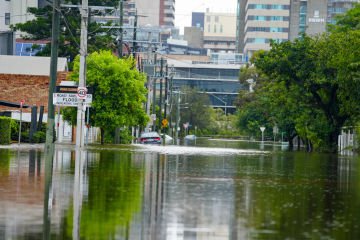
An oped from Suncorp Insurance CEO Gary Dransfield as published in The Australian.
When you see political battlegrounds formed on virtually every major policy issue – climate action, energy, education, border protection to name a few – it is refreshing to see a moment of bipartisanship on another critical issue facing Australia.
The country’s growing natural disaster risk has been put in the too-hard basket for too long. However there was a rare and welcome development in Federal Parliament recently when the Government and Opposition combined to push through amendments to a Bill that will see thousands of Australians across the country better protected from severe weather events.
This will bring economic stimulus to a number of important regional centres, protect vulnerable communities and make insurance premiums more affordable.
The Emergency Response Fund contains a $50 million boost to increase disaster mitigation and resilience. It’s a big win for people living in dangerously exposed areas across the country, including north Queensland. It’s also a win for both sides of politics who demonstrated that they have the capacity to work together on good outcomes for Australians.
Now is the time to bring insurers’ know how into the critical task for targeting areas most in need of these long overdue funds.
It’s imperative that major insurers – rich with claims experience, data and insights – have a part to play in ensuring that taxpayers see returns on this investment are maximised.
The $4 billion Fund, originally set up as a source of sustainable funding for disaster recovery only, was amended through Senate negotiations this month to include a small annual resilience windfall which should be spent immediately with help from industry.
Summer has not begun well and we have already seen out of control bushfires tearing through large swathes of northern New South Wales and southern Queensland, even threatening coastal tourist meccas like Peregian on the Sunshine Coast.
While the Emergency Reponse Fund is a great start, funding does not reach the levels recommended by the Productivity Commission which prescribed at least $200 million a year in disaster mitigation and resilience building - to be matched by the states and territories.
Consider that we spend 97 per cent of disaster funding on recovery and only 3 per cent towards minimising and preventing the devastation in the first place. That’s not fair on the communities who face these threats every year.
With warnings of a subdued economy, building resilience that not only protects vulnerable Australian communities but injects a stimulus and creates jobs seems like a no-brainer. And if we reduce the rising risk of severe weather, insurance premiums will be fundamentally reset and become sustainably more affordable.
Risk mitigation is the smartest investment governments could make with guaranteed returns over time.
There is another funding mechanism looking the Federal Government square in the face. The $5 billion Northern Australia Infrastructure Facility (NAIF) can have its mandate changed to jump-start confidence and growth in the region, focusing on building new flood levees and strengthening homes to protect communities against natural disasters.
Insurers should not be let off the hook either. The industry has an obligation to reward and reprice resilience-building measures whenever and wherever they occur through reduced insurance premiums, and Suncorp, for its part, has routinely done that.
Northern Australia is a vibrant and robust contributor to our nation’s economy, yet if we leave its risks unchecked, we will fail to provide community-level economic infrastructure needed to attract and keep families and businesses in the region.
Let’s not forget there are approximately 100,000 homes in north Queensland that have been built to no cyclone rated standards. They are simply ill-equipped to face a category 4 cyclone.
It seems obvious but if we want to develop the north, we need to better protect the north. The same goes for other communities at risk across Australia.
Our insurance data shows Australia’s regional cities and towns are particularly vulnerable, facing the dual threat of increasingly volatile and severe weather, and a narrower economic base that magnifies the impacts and delays recovery.
Insurance has always played a big part in rebuilding communities. An analysis by SGS Economics and Planning for Suncorp this year showed that following Cyclone Debbie in 2017, without Suncorp’s insurance payouts the Whitsundays would have suffered a permanent loss of 23 per cent GDP – forever changing the region.
Now is the opportunity for governments and the private sector to come together, to not only improve the resilience of this vital economic engine room but to help create jobs, drive economic growth and most importantly, protect the lives and livelihoods of northern Australians. And, of course, lower insurance premiums.



